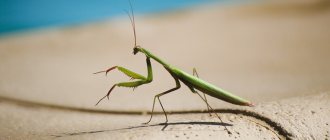Ladybugs sandwich recipe
Ingredients: sliced loaf, butter, tomatoes, pitted olives, parsley leaves. Preparation: cut the loaf into thin slices, each of which is also cut in half. Brush all halves of the slices with butter and garnish with parsley leaves. Cut the tomatoes in half, cut each half crosswise in the form of wings. Make a ladybug head from half an olive. Make black spots for the wings from small pieces of olives, insert them into the wings, piercing small holes with a knife. Place the tomatoes on the loaf slices, and also decorate the sides with parsley. Very tasty and unusual!
If you found the information on the site useful, please share it on social networks:
more
Cookie Policy
about the author
A teacher, philologist, she was engaged in local history work at a school in the village of Magnitka, Chelyabinsk region.
Author of several projects on the history of the Urals. One of the projects is dedicated to the post-war history of the village where the German prisoner of war camp was located.
Lyubov Alyamkina’s stories were published in various magazines and newspapers: “Ural Pathfinder” (Ekaterinburg), “Arguments of the Week” (Chelyabinsk), “District Life” (Kusa), “Russian Germany” (Berlin), “Russian Germans” (Moscow) and etc.
LADYBUG
There was one bug living in the forest. It was so small that it could fit on your little finger. There were tiny black peas on its bright orange wings.
This bug's name was Ladybug.
One day, Ladybug was basking in the sun on a white chamomile petal. How many of them grew here in the clearing!
Ladybug lived very happily and thought that there was nothing better in the world than her forest.
And suddenly children ran into the clearing with noise and cheerful screams.
“Oh, look, Ladybug,” one boy shouted joyfully and carefully took her off the flower, “how pretty she is!”
Ladybug fearlessly walked along the boy's hand, and the children jumped around and sang:
Ladybug,
Fly to the sky
Your kids are there
They eat sweets.
Ladybug thought that this was true and, spreading her wings, flew up. But she didn’t find any of her children there, and no one treated her to candy in heaven. Sad, she sat down on a bush and cried. She so wanted to see her children and eat at least one piece of candy.
At this time, two swallows were sitting on a branch nearby. They hid among the leaves of a tree from a suddenly blowing cold wind.
“Autumn is coming,” said one of them, “and we will fly to warm countries again.”
Ladybug thought:
- What if we fly away with them?
“Take me with you!” she asked the birds.
“We don’t feel sorry, we don’t feel sorry,” they sang.
And when autumn came, the birds rose high, high into the sky, flying to warm lands, not forgetting about the Ladybug, who was so warm and cozy among the feathers of one of the birds. Forests, steppes, mountains, and rivers rushed by below. Ladybug was so tired from the journey that she fell asleep unnoticed.
“Get up, we’ve already arrived,” the swallow woke her up.
It was so wonderful all around! Palm trees, strange plants, bright flowers - Ladybug has never seen such divine beauty. Birds in bright plumage walked among the fragrant bushes.
“I’ll stay here forever!” thought Ladybug.
She sat on an olive branch and thanked the swallow.
“Goodbye!” said the bird. “When we return home, we will fly to you.”
Ladybug didn't answer.
She didn’t even notice how close the Peacock came in his festive attire. He squinted one eye and began to peck at the berries.
Suddenly, Ladybug felt a terrible blow, from which she fell to the ground and miraculously remained alive. It was the Peacock who hit her with his beak. Everything happened so quickly that poor Ladybug barely recovered from her fear and spent the whole day sitting on the ground under a fallen leaf.
Now she had to be careful and hide at times.
Nobody knew her in this country. The grasshoppers did not greet her in the morning, the caterpillar did not crawl past her, having managed to tell the forest news, butterflies with fabulously beautiful wings simply did not want to notice her, flying past indifferently.
And most importantly, no one sang a song to her and was not happy when they met.
Life has become so sad and lonely!
And when the familiar swallows appeared in the sky again, returning to their homeland, where spring had come again, Ladybug’s heart was ready to jump out of her chest with joy.
“I want to go home so bad!” she shouted.
“I know,” answered the swallow, “I thought so.”
So Ladybug found herself back in her native forest.
Now she was not offended by the children’s song, she was happy and laughed with them.
WALK
The little badger lived with his mother in his hole. She warned him all the time:
-Baby, don’t go out alone, because you haven’t grown up yet. You may be in danger.
But one day, when mom was not at home, the little badger got bored at home alone, and he decided to go outside.
The sun was shining so gently, the breeze was blowing so gently that the baby immediately forgot about caution and ran along the forest path
And suddenly he felt that someone had bitten him painfully on the nose. It turned out to be a large mosquito, which was in no hurry to fly away.
“So that’s what you are, Danger!” exclaimed the little badger.
The mosquito laughed:
“My bite will make your nose hurt a little, that’s all, but the Danger is completely different.”
“What does she look like?” asked the baby.
“It’s green, big and croaks so disgustingly!” explained the mosquito. And he flew away.
The little badger walked further. His feet were buried in the greenery of soft moss, the flowers nodded their heads, welcoming him. Suddenly a frog jumped onto a rotten stump.
“Kwa, kwa,” she greeted the baby, looking at his striped back with curiosity.
The little badger's heart sank with fear. But the frog smiled welcomingly at him and asked him to play with her.
“Let's jump rope?” she suggested.
“Come on,” the little badger answered joyfully.
Having played enough, he asked her:
- Tell me about Danger.
“She has wings and a sharp beak,” croaked the frog and immediately hid in the thick grass.
Before the little badger had time to take even a few steps, a magpie sat down on the path. The little badger huddled to the ground. But the magpie, looking at him friendly, handed him red berries in her beak, so large and ripe that the baby could not refuse such a treat.
“Eat, they’re so tasty,” the magpie chattered, “I know a clearing where there are a lot of them.”
“So you’re not Danger?” asked the kid, gobbling up berries on both cheeks.
“Where is the Danger, where?” the magpie chattered again, looking around.
-What is she like?
“So you haven’t seen her yet?” the new acquaintance was surprised. “She’s red, with a bushy tail.”
And the magpie quickly flew away.
The kid also decided to hurry home. At that moment a squirrel appeared next to him.
“Oh!” cried the little badger.
Now he was convinced that he had encountered real danger.
“Why are you scared?” the squirrel was surprised. “Do you want me to treat you to some nuts?”
“I’m afraid of you because you’re red and have a tail,” the little badger explained to her.
“But I’m not a fox,” she explained, guessing who she was mistaken for, and instantly jumped onto a tree and threw him nuts from there.
The little badger was so hungry after a long walk that he ate the delicious nuts with gusto.
And when he came home, his mother was already waiting for him and was terribly worried.
The little badger told her about his adventures.
“The danger is different for everyone, everyone has their own,” his mother explained to him and affectionately stroked his head.
Where do they live?
Ladybugs can be found in almost every corner of the world, with the exception of northern latitudes (Antarctica and other polar regions).
The active period of their life activity occurs in the spring-summer period, when there are a lot of aphids and other small insects that red bugs can feast on in abundance.
As for specific habitats, they feel most comfortable in open areas with lush vegetation (lawns, clearings, forest edges, etc.). Others prefer to live in reed thickets (along water bodies). The optimal temperature for insect life should be at least +10 degrees.
Security
The ladybug is already listed in the Red Book in many countries, including Russia.
If this insect completely disappears, humanity will face an imbalance in nature and the active proliferation of dangerous pests, which will have to be destroyed chemically.
Therefore, today ladybugs are successfully bred in laboratory conditions , and then released into the fields. But in order to maintain balance, it is necessary to abandon the chemical destruction of aphids and direct general efforts to improve the ecological situation of the environment.
Ladybugs are amazing creatures of nature that bring great benefits to people (with the exception of herbivorous species). They protect crops from various kinds of parasites, thereby preserving the harvest and allowing humanity to do without chemicals. However, in recent years the number of these beneficial insects has noticeably decreased, so they are listed in the Red Book and attempts are being made to restore the population artificially.
What does it look like?
The insect has a rounded, egg-shaped body, flattened at the bottom and convex at the top.
Juveniles most often have a bright red color (but other colors also exist).
On the back of the ladybug there are black dots with a diameter of 1–2 mm. However, their number varies and depends on the type of insect.
The body size ranges from 4 mm to 1 cm (maximum).
There are also flexible multi-segmented antennae and hard, expressive elytra. Interesting fact! When flying, an insect makes an average of 85 beats per second.
All about the benefits and harm
- The benefit of ladybugs is that they eat large quantities of parasites - pests of agricultural land. Therefore, they are specially bred at enterprises for the appropriate purpose.
- Herbivorous species of these insects can cause harm to humans , causing irreparable damage to agricultural crops (in particular potatoes, cucumbers, tomatoes and sugar beets). But most of these species live exclusively in tropical countries.
Why is it called that?
Here are some of the versions of the origin of the name:
- In ancient times, the insect was personified with the thunder god - Perun.
The ladybug was credited with the ability to influence the weather and was perceived as a link between mortal people and the gods. - Catholics considered her a messenger of the Mother of God.
- The British associated the insect with the Virgin Mary.
But the most optimal and plausible version of why the bug was named so is that the insect secretes a poisonous white liquid (the so-called “milk”) to scare away predators. And “God’s”, probably because it helped fight aphids and other agricultural pests and did not harm humans.
Interesting fact! The Slavs considered the ladybug to be a direct messenger of the sun. Therefore, it was impossible to drive her away, much less kill her. Otherwise, you could “turn away” your luck.
What kind of lifestyle do they lead?
Regardless of the species, ladybugs lead a solitary life, showing a bright image of individualists . These insects are collected only for procreation. They also form flocks to fly to warm places (because they don’t like the cold).
But there are also sedentary individuals who huddle together during the winter in some secluded, abandoned place (under fallen bark, tree foliage, etc.). With the onset of warmth, they leave their shelter, scattering across meadows and clearings.
Origin of the species and population
The ladybug is an arthropod insect from the order Coleoptera. This bug received its scientific name (Coccinellidae) due to the scarlet coloring of its body. There are many varieties of ladybugs, and the entire family contains more than 4,000 species.
Over the past couple of decades, the population of ladybugs has decreased amid active control of aphids. And, as a result, the little red bugs had nothing to eat.
The situation became very sad when scientists made one irreparable mistake (of course, guided by good intentions). In order to maintain the population, millions of artificially raised individuals were released into the natural environment, which, due to existing gene mutations, dramatically changed their diet, choosing their own relatives as food. This resulted in the death of a huge number of beneficial bugs, so in all European countries their populations have noticeably decreased.
Varieties, their names, descriptions and photos
Below is a description of what ladybugs are, a detailed description of the most interesting varieties; You will also be able to see their photos, including close-up photos.
Point-to-point
The body length of the two-spot ladybug reaches about 5 mm. The color is dark red with two parallel black dots on the back (hence the characteristic name). The body has an oblong-oval, moderately convex shape.
The head of light-colored individuals is black, with two large irregularly shaped spots (near the eyes). Dark bugs have a completely black head.
Seven-point
The seven-spotted ladybird is one of the most common species in Europe . The body size is about 8 mm. The color is red, and there are 3 black spots on the sides. The seventh spot is located near the head.
Twelve-point
The twelve-spotted ladybird reaches 6 mm in length. It has a red or pink color. There are 6 black dots on each elytra. The insect lives primarily in North America and feeds on pollen from agricultural plants.
Thirteen-point
The thirteen-spotted ladybird has 13 spots on its surface. Color - red-brown or brick. In this case, some spots may merge with each other. The insect is common in Europe, Asia and North America.
Asian
The Asian ladybird or Harlequin reaches a length of 7 mm. It is either yellow-black or black-orange in color . The insect lives in Asia and feeds on aphids.
Note! This species is characterized by the greatest gluttony, therefore it is specially cultivated in Europe and North America to combat agricultural pests.
Ocellated
The ocellated ladybug is considered one of the largest and reaches a length of approximately 1 cm. The color is red or yellow. In this case, each of the spots is surrounded by a lighter halo. There are 20 such “eyes” on the back of the insect.
Pointless
The spotless ladybird is one of the rarest species , characterized by a complete absence of dark spots. The body of the insect is red or brown in color and covered with barely noticeable fibers. The insect reaches several millimeters in length.
Blue
The blue cow is the most unusual representative of this family. A distinctive feature of the insect is the blue color of the elytra with a characteristic metallic sheen. Dark spots on the back are absent (or simply not visible, because they merge with the dark blue color).
It lives in the eastern part of Australia, as well as in New Zealand. The insect feeds mainly on aphids. The body size does not exceed 4 mm.
How do they reproduce, are born and develop?
Insects reach sexual maturity at approximately 3–6 months of life (depending on the species).
Their mating season begins with the arrival of spring. The female produces a characteristic odor, thanks to which the future chosen one finds her. Next, mating occurs, and the female lays eggs (most often near colonies of parasites to provide food for the offspring).
The eggs are oval in shape with slightly tapered ends. Color - yellow-orange. In one clutch, the female manages to lay about 400 eggs . After 1–2 weeks, the larvae are born.
The ladybug goes through the following stages of development:
- larva remains in this state for 1–2 months.
- The pupa attaches itself to the grass and spends 7–10 days in this position. It is during this period that the necessary parts of the body are formed.
- An adult lives from several months to 1–2 years.





